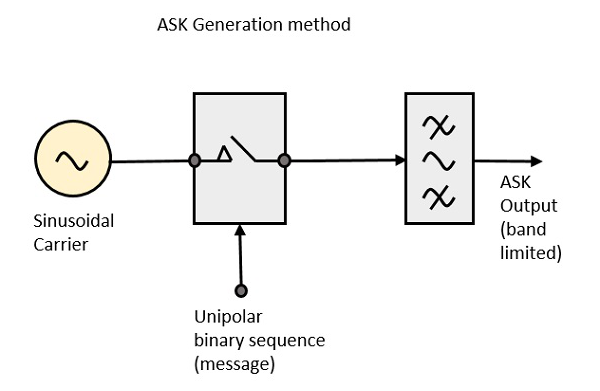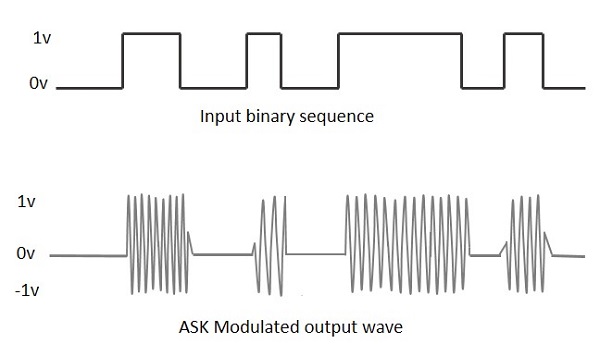Amplitude Shift Keying Tutorial
Any modulated signal has a high frequency carrier. The binary signal when modulated using Amplitude Shift Keying ASK results a zero value for Low input and Carrier output for High input.

Amplitude Shift Keying Tutorialspoint
Below diagram represents ASK modulated waveform with its input.

Amplitude shift keying tutorial. Amplitude Shift Keying Theory Amplitude Shift Keying. To study ASK Amplitude Shift keying Modulation generate ASK signal using switching method. Mewakili logika 0 dan 1ASK Amplitude Shift Keying merupakan suatu modulasi di mana logika 1 diwakili dengan adanya sinyal dan logika 0 diwakili dengan adanya kondisi tanpa sinyal.
Thus the modulated waveform consists of bursts of a sinusoid. A hybrid of amplitude and phase mapping is called quadrature amplitude modulation QAM. These are related to the number of levels adopted by the digital message.
What is Amplitude Shift Keying. Amplitude shift keying is simply toggling between two RF power levels that denote serial ones and zeros In the case of OOK the zero is actually No carrier for all practical purposes in this discussion ASK and OOK are identical. An essential part of electronic communications and telecommunications.
Amplitude shift keying - ASK - in the context of digital communications is a modulation process which imparts to a sinusoid two or more discrete amplitude levels 1. If the message is mapped only to the phase of the carrier the modulation is called phase shift keying or PSK. In amplitude shift keying ASK the carrier signals strength varies to describe binary 1 or 0.
The signals peak amplitude during each bit duration is continuous and its value is based on the bit 0 or 1. Amplitude Shift Keying ASK is a type of Amplitude Modulation which represents the binary data in the form of variations in the amplitude of a signal. The binary signal when ASK modulated gives a zero value for.
Mathematically amplitude-shift keying is 212 where vask t amplitude-shift keying wave vmt digital information modulating signal volts A2 unmodulated carrier amplitude volts ωc analog carrier radian frequency radians per second 2 πfct In Equation 212 the modulating signal v mt is a. In ASK amplitude leve. On-off keying continuous wave and interrupted continuous wave.
Amplitude Shift Keying ASK1. PSK technique is widely used for wireless LANs bio-metric contactless operations along with RFID and Bluetooth communications. Phase Shift Keying PSK is the digital modulation technique in which the phase of the carrier signal is changed by varying the sine and cosine inputs at a particular time.
For a binary message sequence there are two levels one of which is typically zero. Modulation is called frequency shift keying or FSK. The simplest and most common form of amplitude Shift Keying operates as a switch using the presence of a carrier wave to indicate a binary one and its carrier wave to indicate a binary zero.
Amplitude Shift Keying Objective. In analog modulation we were interested in the SNR but recall from Chapter 10. In this video i have explained Amplitude Shift Keying ASK with following outlines0.
The output of a FSK modulated wave is high in frequency for a binary High input and is low in frequency for a binary Low input. FSK is a scheme of frequency modulation. Both frequency and phase remain constant while the amplitude modifies.
Frequency Shift Keying F S K is the digital modulation technique in which the frequency of the carrier signal varies according to the digital signal changes. A bit duration is a time that represents one bit. Voltage levels are left to designers of the modulation system.
Amplitude Phase Shift Keying APSK Amplitude phase shift keying APSK a variation of both M-PSK and QAM was created in response to the need for an improved QAM. When AM is used for multiplexing digital data it is known as amplitude shift keying ASK. While frequency and phase of the carrier signal remain constant.
This type of modulation is called On-Off keying. Pada teknik modulasi ASK data digital yang ditumpangkan direpresentasikan dengan cara mengubah-ubah amplitudo gelombang pembawa. Here strength or amplitude of carrier signal is varied to represent binary 1 and binary 0 data inputs.
Amplitude Shift Keying ASK Modulation Code in MATLABAmplitude Shift Keying is one of the basic types of digital modulation techniques. Basics of Amplitude Shift. In this type of Amplitude Modulation binary data is represented in form of variations in the signal amplitude.

Amplitude Shift Keying Ask Modulation Code In Matlab Matlab Tutorial Youtube

Amplitude Shift Keying Tutorialspoint
Amplitude Shift Keying Modulation Digital Signal

